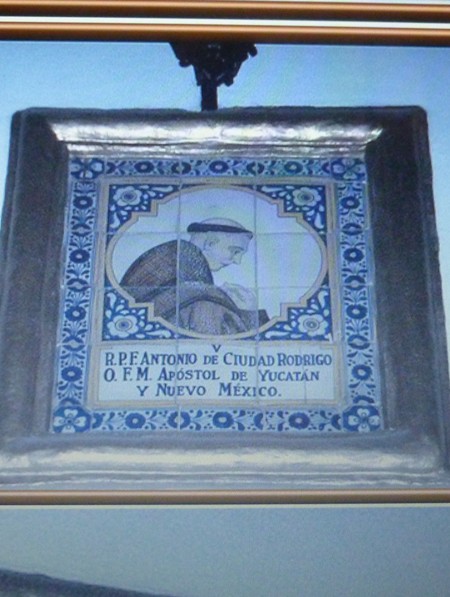Multiples adventures
Dominicans and Franciscans in Maya land - XVIth century
A trip by Las Casas to Tabasco and Chiapas
Pedro de Barrientos in Chiapa de Corzo
Las Casas against the conquistadores
Fuensalida and Orbita, explorers
Numerous studies
An ethnologist friar, Diego de Landa
Two teachers, Juan de Herrera and Juan de Coronel
Two historian friars, Cogolludo and Remesal
A multitude of buildings
A Franciscan turned architect: Friar Juan de Mérida
The Valladolid convent in the Yucatán
The Izamal convent and its miracles
In the Yucatán, a church in every village
A Dominican nurse, Matías de Paz
A difficult task: evangelization
The creation of the monastery of San Cristóbal
The Dominican province of Saint-Vincent
An authoritarian evangelization
Franciscans and the Maya religion
The failure of the Franciscans in Sacalum, the Yucatán
Domingo de Vico, Dominican martyr
The end of the adventure
Additional information
The Historia Eclesiástica Indiana of Mendieta
The road of Dominican evangelization in Guatemala
The convent of Ticul, as seen by John Lloyd Stephens
The Franciscans in the Colca valley in Peru
The convent route of the Yucatán in the XVIth century
The dominican mission of Copanaguastla, Chiapas
Available upon request: -
general information upon Maya countries, - numbered texts
on the conquest and colonization
of Maya countries
Address all correspondence to:
moines.mayas@free.fr
|
THE HISTORIA ECLESIÁSTICA INDIANA BY FRAY GERÓNIMO DE MENDIETA
|
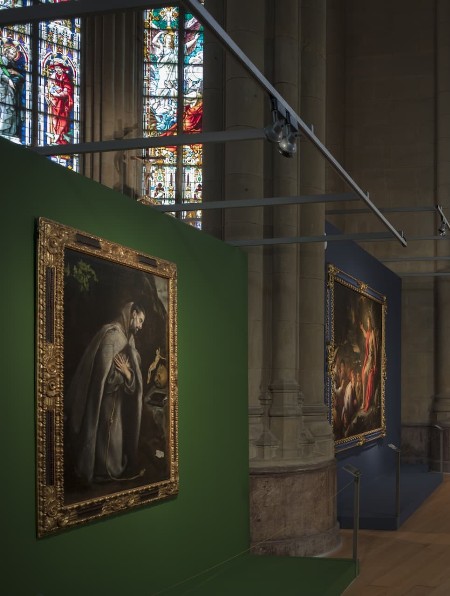
El Greco, Saint Francis kneeling in meditation, in the Museo Diocesano de Arte Sacro, Vitoria, Spain, Mendieta's birthplace
Fray Gerónimo de Mendieta (1525-1604)
Born at Vitoria, Spain, 1525; died in the City of Mexico, 9 May, 1604. While still a youth he took the habit of St. Francis at Bilbao, and arrived in New Spain at the end of June, 1554. Being desirous of helping in the conversion of the Indians, he applied himself to study the Mexican language. In 1569 Mendieta accompanied Miguel Navarro on his way to the general chapter in France. On 26 June, 1571, his general ordered him back to New Spain, then Mendieta set out in 1573, taking with him several religious of his order. In 1575 and 1576 he was guardian of Xochimilco; in 1580 he was at Tlaltelolco, and in 1585 was superior of the convent of Tlaxcala. Soon after this he accompanied the commissary, Alonso Ponce, on visitations, and by his tact and prudence kept himself out of those troubles which arose within the order from the opposition of the provincial and his partisans to Ponce's execution of his commission. In 1591 he was guardian in Santa Ana of Tlaxcala, and in 1597 of Xochimilco. He was buried in the convent of Mexico.
Mendieta's principal work is his "Historia Eclesiastica Indiana". The general, Cristóbal de Capitefontium, gave him the command to write it on 27 June 1571; the work was not completed until 1596. Mendieta wrote at a time when many eyewitnesses of the initial contact between Indians and Europeans were still alive; he utilized their information. He also drew not only on the works of Motolinía, but on those by Andrés de Olmos, Bernardino de Sahagún, and others in the archives of the Convent of San Francisco, in Mexico City. Mendieta sent his work immediately to Spain, as he had been ordered to do, and never had any further knowledge of it. The manuscript, acquired at Madrid, was printed in Mexico in 1870 through the exertions of Joaquin Garcia Icazbalceta.

Mendieta's imaginary portrait (El Correo, 2023, November)
FRAY GERÓNIMO DE MENDIETA,
HISTORIA ECLESIÁSTICA INDIANA,
1596.
Book four of the religious Indian history – Of the spiritual conquest of the Indians from New Spain and the progression of their conversion
Chapter I – The first priests of the Dominican Order who founded such an order in our New Spain
Friar Domingo de Betanzos
[…] “They have another autonomous province in Guatemala, which is part of our New Spain. It was founded the same way as in Mexico, by Friar Domingo de Betanzos, in conformity with the rules of the Order, as he was a very ascetic man, submitting himself to rigorous penance, and was an example of all virtues, and he thus undertook to set up his Order by following the habits and saintly ceremonies that were established at the time of the Order’s creation during the time of Saint-Dominique. And all the companions who were with him in Guatemala followed his example with much fervor, walking barefoot and dressing poorly, just like their Franciscan brothers. They categorically refused to receive any stipend and so it was for thirty years. Afterwards, they had to travel by horse and must receive a stipend, as authorized by the saintly Council of Trente. Father Betanzos did not understand the Indians very well and could not speak their language. He had predicted that the Indians were about to disappear, which revolted many. I am of the opinion that while he set a date for their disappearance, as it is believed, he was in the wrong, since years have gone by and the Indians are still here. And if he did not set a date, I am sure that someone else will, as the cupidity and disdain of the Spaniards is well known, and the Indians cannot defend themselves, they are sardines compared to these small whales; all the more so this father who had himself seen the Indians from the islands die away”.
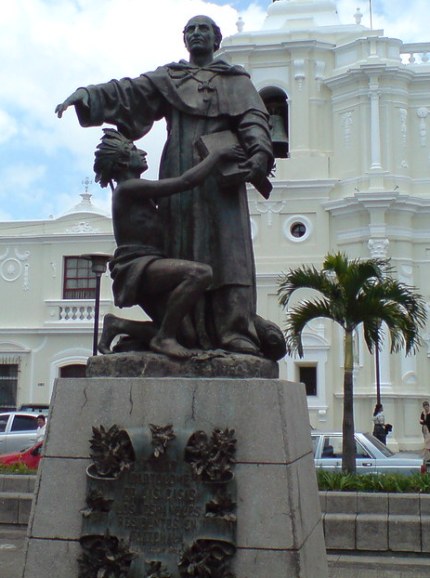
Statue of Bartolomé de Las Casas in Guatemala City
Friar Bartolomé de Las Casas
“And since we are remembering the glory of those who deserved it for working so faithfully and apostolically to converting the Indians, it would be normal to do the same for the man who, among other priests, worked harder than anyone else and did even more for their protection and their evangelization. It is the Bishop of Chiapa, D. Friar Bartolomé de Las Casas, of the Order of blessed Saint-Dominique who, even before he joined the Order, was a clerk in the Spanish island and began with a very Christian and merciful zeal to call on divine clemency and to expose to the catholic kings soon before they died, and to Charles Quint their grandson and blessed Emperor, the great destruction and devastation committed by the Spaniards towards the Indians from these regions. Then, once he became priest and bishop, he gave up his bishopric to become their Procuror, appearing at the court of these Majesties and during twenty years endured much embarrassment, suffering and contradictions when learning from his brothers, and especially from the Franciscans living in New Spain, that the recently converted Indians were submitted to harassment and injuries. He helped with zeal to protect a great many of them and to free those who had become slaves, and he also prohibited slavery from then on. He was very cultivated and knew how to write very well. He wrote many treaties in Latin and in Spanish, explaining logically and on the basis of human and diving rights why the Indians should be free and well treated, and explained why the Kings of Castile had the obligation to defend and protect them. I am convinced without a doubt that he enjoys a particular glory in heavens and that he is crowned with a glorious crown because of his hunger and thirst for justice during his life and because of the zeal he demonstrated up to his death for the love of God, by tending to the poor and miserable people that were deprived of grace and any kind of help. His disciples worked assiduously to tell the truth. I hope to God that they received from his Majesty a minute share of what he got and deserved, as we believe […].
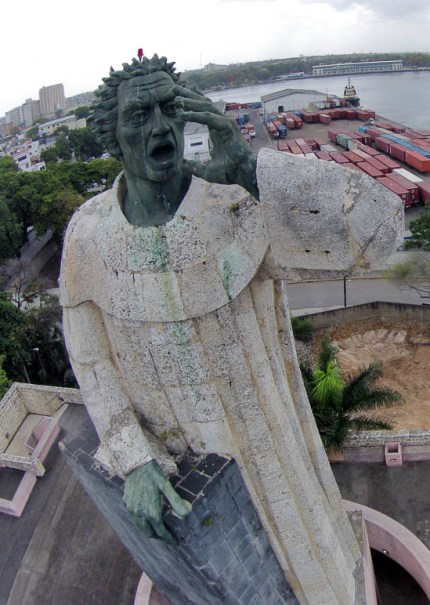
Writing his "History of the Indies", Bartolomé de Las Casas brings us to light Friar Antonio de Montesinos' sermon, beginning of his own vocation (Monument to Montesinos, Santo Domingo, sculptor Antonio Castellanos, 1982)
"I am the voice of one crying in the wilderness [...] Tell me, by what right or justice do you hold these Indians in such cruel and horrible slavery? By what right do you wage such detestable wars on these people who lived mildly and peacefully in their own lands, where you have consumed infinite numbers of them with unheard-of murders and desolations? Why do you so greatly oppress and fatigue them, not giving them enough to eat or carrying for them when they fall ill from excessive labors, so that they die or rather are slain by you, so that you may extract and acquire gold every day?" Friar Antonio de Montesinos, 1511
Chapter VI – Of the foundation of the [Franciscan] province of Yucatan and the saintly apostolic men who honored it.
The province of Yucatan
“Yucatan, also called Campeche by some, draws its name from one of its villages and fishing towns. Some call it Champoton, and it is a province that looks like an island, like Spain, as it is surrounded by the sea on three sides, but unlike Spain, it is surrounded by the sea on the east, the west and the north sides, and it is only on the south side that it is attached to the continent. And in fact, it stretches further in the direction north-south than from west to east, where it is not larger than one hundred leagues. Yucatan is located at more or less three hundred leagues east of Mexico, leaning a little towards the south, so that the ships that go from Spain to the port city of Veracruz travel along its left side. It is a very warm region, but with a healthy climate since it is very dry and possesses no rivers or lagoons : all the water that is used comes from wells and rivers that run underground. Its people die of old age since there are no diseases, contrary to other regions and if there are indeed miasmas, they are burnt by the heat; so it is said that doctors are not needed in the region.
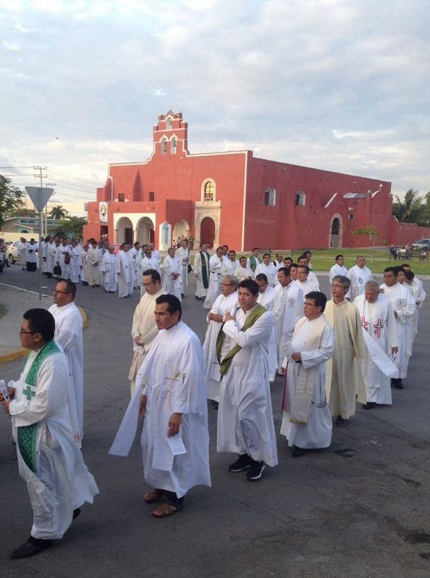
Campeche, 2016, october 16, procession in front of the former Franciscan convent of the town
Friar Jacobo de Testera
“Regarding the spiritual founding of this province and the introduction of the gospel there, it must be said that the first person who went there to bring the news of our saintly faith and to preach it to the Indians was father Friar Jacobo de Testera in 1534, with four other priests, when he was custodian of Mexico and before the province became a Franciscan province, since this saintly father (a highly spirited and fervently zealous man eager to save souls) not only spread preaching and teaching those he was responsible for in the kingdom of Mexico and the surrounding area, but he also wanted to convert and introduce the Creator not only to all the Indians but to all the inhabitants of the world. With this objective in mind, he covered every inch of the whole territory so far discovered. Thus he went to Michoacan and to Guatemala (as confirmed by a surviving Indian who was his servant and whom he took with him to Spain when he went to the General Chapter of Mantua). I could not verify this fact. He also went (as I just said) to Yucatan, where he was welcomed by the Indians who were quite open and happy to receive the word of God, and whom he thanked for letting him give them salvation. He began to gather and teach the sons of the notables, as had been done in Mexico, and thereafter he and his companions advanced the cause of the church and worked to eliminate the Indians’ devotion to idols, so much so that many people joined them.

Champotón, river and town
The Spanish soldiers, noting that the friars had succeeded in taming the Indians and had gathered them in the school, began to debauch them and to use them as servants, and to disturb them to such an extent that they totally impeded evangelization: it was already rather difficult to gather them and the soldiers prevented those who came from learning the teachings of the friars. Friar Jacobo stood up against the soldiers to prevent them from the excesses they committed, so much so that fights and dissensions occurred. And the soldiers gave so much trouble to the father that he had to leave and go back to Mexico with his companions, realizing that with so many obstacles and such lack of support, it was impossible to succeed with the Indians who then remained without evangelization. It is said that the insolence of these bad Christians went so far that they forgot their fear of God and their honour, and they brought idols that they had bought or taken in other regions and they resold them to the Indians of Champoton; they told them not to believe what the friars preached in order to move them away from religion and to use them for their own purposes. What worse can be said about these men who were christened and were sons of old Christians? And how far will the cupidity of these blasphemous Christians take them? The Apostle was right when he said that cupidity and miserliness were the slavery of idols because they lead the Christian man to worship idols and to renounce the true God.
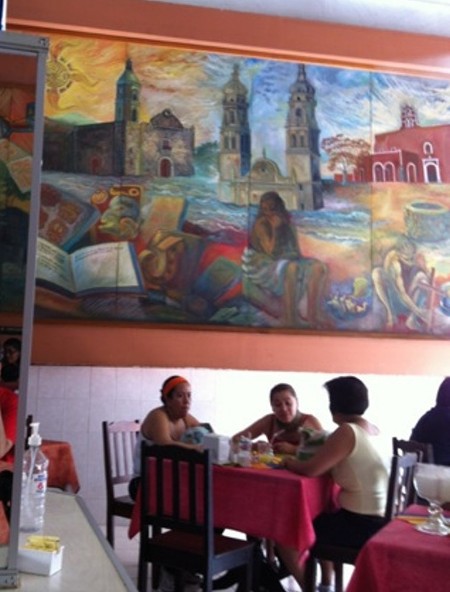
The churches of Campeche, canvas in "La Parroquia" restaurant, Campeche, Yucatan
Five other priests
“The other priests that came to Yucatan had been sent by father Friar Antonio de Ciudad Rodrigo, a provincial from our province of the saintly Gospel, to find new people to whom they could preach God’s law and the kingdom of heavens, as is told by father Friar Toribio Motolinea, his companion (both belonged to the group of twelve). Father Friar Toribio said that in the year 1537 his friend Ciudad Rodrigo sent five brothers to the coast of the North sea; they preached and taught the indigenous people of the villages of Guazacualco and Tabasco, where lived a Spanish population called Santa Maria de la Victoria, and they reached Xicalango. Following down the coast, they reached Champoton and Campeche, villages in the region which the Spaniards call Yucatan. The trip and visit to the Indians took them two years and they found that the Indians were able and disposed to welcome our faith and beliefs, since they eagerly listened and learned the Christian doctrine (as if the absence of father Friar Jacobo had given them a taste for it). These brothers noticed two things about the Indians : one is that they always told the truth and the other was that they never stole anything from each other, even if something had been abandoned in the street for several days. This is what said father Friar Toribio. And the five priests returned to Mexico, because it seems that they had been told not to stay but to come back and brief their prelate.
Antonio de Ciudad Rodrigo, Convento Santa María Magdalena, Texmelican, Puebla
"In general terms we have already mentioned the extreme poverty and conditions of penance in which these fortunate brethren, our predecessors, lived, who by means of their sermons implanted in the mind of the Indians the knowledge of the Gospels. […] When Father Ciudad Rodrigo, as superior of the convent of Mexico, refused to accept a jug of wine which the saintly Archbishop Zumárraga sent him as a festive present for the friars, he returned it with thanks, saying that because he loved his friars so much, he requested him not to allow any relaxation which would inevitably lead to the growth of bad habits."
(Fray Jerónimo de Mendieta, Historia eclesiástica indiana, Libro III, Capítulo XXXI, De particulares ejemplos de abstinencia y pobreza de aquellos apostólicos varones para nuestra imitacion)
Friar Luis de Villalpando and his companions
“The third group that came to Yucatan and settled there was composed of four priests sent by Friar Toribio just mentioned in the year 1542 from Guatemala. Indeed, father Friar Jacobo de Testera, who had just returned from the General Chapter of Mantua as general commissioner, sent Friar Toribio to Guatemala with twelve brothers he had taken from the province of Saint-James (that of Salamanca), among which was Friar Toribio who, after arriving in Guatemala and having organized there the expedition, sent away the four brothers I mentioned to Yucatan; they were saintly men quite capable of accomplishing what had to be done. Their names are: Friar Luis de Villalpando, a confirmed and quite knowledgeable priest, the first one who knew the Yucatan language fluently and who drafted the grammar and vocabulary of that language; Friar Lorenzo de Bienvenida, who lived for a long time in the country and worked in the field until a province was created there, as is explained further; Friar Melchior de Benavente, a saintly priest who, suffering from the heat which affected his health and well-being, had to come back to Mexico where he went on being a saintly priest, as will be seen in the story of his life related in the Fifth Book of the present History; Friar Juan de Herrera, a lay brother, who managed a school there for several years and trained many capable disciples as readers, writers and singers. He then came to our province of Mexico, and then to the custody of Zacatecas, carried by the Spirit during these trips, and at the end he became a martyr since the Chichimèques killed him, just as they killed many other brothers, as will be seen further. Thanks to these priests, preaching and teaching our saintly faith found their places in Yucatan. Afterwards, others came to help them and to learn the Maya language which was taught by Friar Luis de Villalpando ; he is worth remembering for doing so and also because he was the first one to master it and to preach in that language, setting an example as a true priest.

The Motolinía fountain, in Puebla, was defaced by activists who painted the words "colonialismo" and "genocidio" on it, October 2024
Friar Lorenzo de Bienvenida
“Friar Lorenzo de Bienvenida is also worth remembering for all this work and the multiple trips he took until Yucatan became a province and formally obtained this title. Since the province had only two monasteries (and here is the story of his travels), one in Merida where the Spaniards live, and the other in Campeche, he went to Mexico around the year 1550 and he obtained from father Friar Francisco de Bustamente (who at time was General Commissary of all the Western Indies) the promise that both these monasteries, which were isolated, would become a fully operational custody dependent upon our province of Mexico. Later on, when more convents were created, he went to the General Chapter of Aquila in Italy which met in 1559, and was able to have the custodies of Yucatan and Guatemala made into provinces as long as the Chapters were held in turn in each province and as long as the provincials were elected first by one province and then by the other: Guatemala would be General Vicar for the whole region (both regions being far from each other); when the provincial was in the hands of Guatemala, the guardian of Mérida would become its Vicar on behalf of Yucatan. But this partnership did not last long (because of Friar Lorenzo) because Friar Lorenzo also attended the General Chapter of Valladolid and succeeded in having each one of the regions of Yucatan and Guatemala become autonomous provinces, and the province of Yucatan took the name of Saint-Joseph. The province now has twenty-two convents and the whole bishopric has no priests other than those of Saint-Francis, and four out of the five bishops it has had up to now are Franciscan brothers.
Friar Francisco de la Torre
“Friar Francisco de la Torre, of the province of Saint-James, was one of those who worked hardest with the Indians, showing them the example and preaching to them, as he was a good interpreter of the Maya language, and even though he was several times custodian and provincial, he was always humble with everyone, so much so that he was always loved and respected by all, Spaniards and Indians alike. It is said that he had the gift of prophecy and that soon before his death he was seen floating above ground while praying. What I know is that I knew him as a faithful servant of God and a very patient man who, suffering from terrible asthma, went to Mexico to find a cure, and since he did not find any, came back to Yucatan and died.
Friar Diego de Landa
“Friar Diego de Landa, of the province of Toledo, was also a highly knowledgeable priest of the Maya language and a great worker in that region for many years. He faced strong opposition and persecution from the Spaniards, because he denounced the tyranny with which they treated the Indians, but also from the Indians themselves because he had discovered that some of them went on with their rites of idolatry after becoming Christians and he had them punished severely, and it is said that they tried to kill him with witchcraft and spells, but the Lord protected him always and he slipped away. One year, when he was guardian, there was great starvation in the country and many Spaniards and Indians died; they were six months away from the harvest and he had barely a month worth of food for his convent, but he ordered that no one requesting bread at the entrance of the convent should be turned away. And while much bread was distributed, the same quantity of corn was found in the convent when starvation stopped as when he had given the order. He had to return to Spain as he was found to be too severe in his punishment of the Indians, and even the bishop, who was a brother of the same order, was among those who accused him the most. Yet, after the Royal Council of the Indies considered the case, and after his adversary the bishop died, he was promoted to the rank of bishop by our church of Yucatan because of his merits and his exemplary life. It is said that when he preached, a crown was sometimes seen on his head, and a star above it. He came back as bishop in 1573 and died in 1579. Upon his death, those who had been his enemies acknowledged his sainthood and his being chosen by God. Such is the strength of truth: even if it is stolen at times by man’s perversity, it always comes back in the end. Our province of Yucatan is well settled, as far as the devotion of the friars is concerned as well as the teaching and preaching to the Indians. This is because the Indians all speak a same language, because the ministers all come from the same order, and especially because the Spaniards do not live in the villages of the Indians.
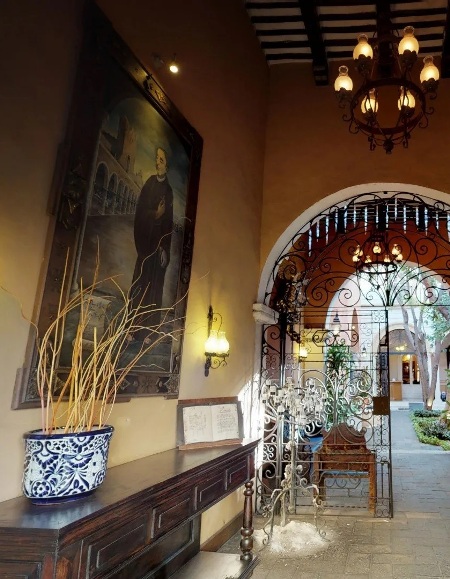
A portrait of Diego de Landa in the hotel "La Misión de Fray Diego", in Mérida, Yucatán
Chapter VII – Of the creation of the [Franciscan] province of Guatemala, and the saintly men who honoured it
Bishop Marroquín brings in the Franciscans
“The province of Guatemala is located 250 leagues away from Mexico, towards the South-East. It is a large region, not very well known and with few inhabitants, even though it enjoys a temperate climate, fertile soil and is rich in food. It seems that in 1539, six priests left the province of Saint-James on the order of the first bishop of Guatemala D. Francisco Marroquín, who paid for their trip to our New Spain and province of Mexico : they were Friar Alonso de Casaseca (called Eras by Rmo Gonzega), their chief Friar Diego Gordóñez, Friar Gonzalo Méndez, Friar Francisco de Bustillo, Friar Diego de Alva, a priest, and Friar Francisco de Balderas, a lay brother. The prelate Friar Alonso de Casaseca got sick upon leaving Mexico for Guatemala and died in Tepeaca, where he is buried. The remaining five arrived in the city of Guatemala and were greeted with much joy, charity and honours by the Spaniards as well as by the Indians who had already heard about the Franciscan Friars and eagerly wanted to benefit from their teachings. And soon after, thanks to alms from individuals, a piece of land was purchased and a location was found where to build the monastery. Their first task was to learn the language of the Indians.

Antigua Guatemala, mass in the church of Saint Francis, 2024
Friar Francisco de Valderas
“But since they were but a few facing so many people, having agreed with the bishop himself and the Royal Audience, they sent the lay brother Friar Francisco de Valderas, a trustworthy and very active man, to find other brothers in Spain. And in fact he arrived quickly in Spain and was able to find twelve brothers from the same province of Saint-James; it was agreed to entrust them to him and they were all very religious and knowledgeable, and he led them through the same path as he and his companions had taken before, and they landed in the harbor of San Juan de Ulúa, in the province of Mexico. But he sent them right away to Guatemala, and since the trip to reach it is long and difficult and they arrived exhausted, most of them died and the help brought by the lay brother was thus of little use.

Antigua Guatemala: Holy Week procession in front of the church of Saint Francis (2023, April)
Hard beginnings
“But God helped them find help from somewhere else, as at the very same time, father Friar Jacobo de Testera came back from the General Chapter of Mantua with the title of General Commissary of the Indies, and he was accompanied by fifty brothers; he sent to Guatemala father Friar Toribio Motolinea with twelve of them, all from the same province of Saint-James, as has already been stated. Among them was a certain Friar Pedro de Betanzos who at that time knew better than the others how to speak the language of the Indians (which is very strange and difficult to pronounce), and who conceived a written grammar and vocabulary; and then a certain Friar Francisco de la Parra improved this work by adding four or five letters, or rather, four or five characters to help pronounce the language more easily, as our a, b, c were unable to do so. When father Friar Toribio left again for our province of Mexico, this settlement began to die slowly and was almost gone, because the new General Commissary father Friar Francisco de Bustamente, having heard that these priests did not get along, summoned them to Mexico. But the good bishop D. Francisco Marroquín (quite devoted to our Order) did not agree and kept them from going and wrote to the Commissary. The Commissary then came, in 1550 or 1551, accompanied by the famous D. Antonio de Mendoza, his close and devoted friend who was going to Peru to fulfill the post of Vice-Roy. He then gathered a chapter and named it Custody of the Name of Jesus. Up to then they had been managed only by a commissary whom they chose among themselves or who was appointed by the superior prelate. Afterwards, during the General Chapter of Aquila, en 1550, thanks to the negotiations of Friar Lorenzo de Bienvenida, this custody was changed into a province (as has been stated) as well as the custody of Yucatan, and finally during the General Chapter of Valladolid, in 1565, both custodies became one province.
The Franciscan province of Guatemala
“The province of Guatemala now possesses twenty-two monasteries of our Order, but many of them are very poor and have very few priests. The Dominican fathers have fourteen convents, without the visiting villages, with more beautiful buildings than those of our monasteries, and moreover they have good convents in Chiapas and in Verapaz, which are other provinces. The fathers of the Mercy have six buildings. The father clerks have twenty-two, all in hot soil and rich thanks to cocoa that is grown there, a fruit that looks like an almond which, when dried is sent throughout New Spain; it is used as money to buy small things and, when turned into powder, to prepare drinks used on a daily basis. The main town and district where the cathedral is located and where the Royal Audience (called the Confines) lives is also called Guatemala, exactly like the whole province; but the Spaniards who came and settled there called it Saint-James, adopting this blessed apostle as their patron”
.
(Chapter translated by Chantal Burns)

Antigua Guatemala, the church of Saint Francis was damaged by earthquakes in XVIIIth century. It was returned to Franciscan friars in 1960, who rebuilt it in 1961 to 1967. The church remained in operation
2025 "Friars and Mayas"
|

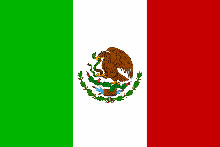

Historia Eclesiástica Indiana manuscript (1596), title page
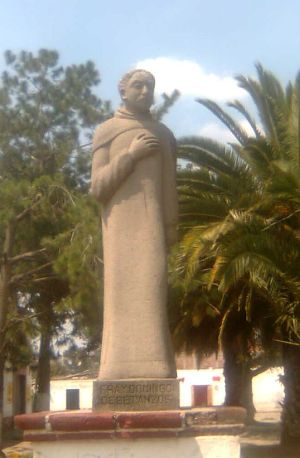
Friar Domingo de Betanzos' monument at Tepetlaoxtoc
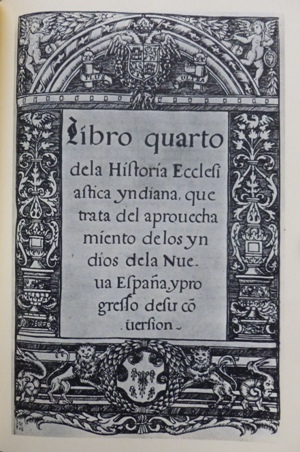
Historia Eclesiástica Indiana manuscript, book fourth heading
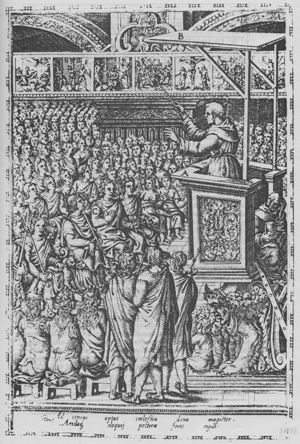
Historia Eclesiástica Indiana manuscript, print from fray Diego Valadés Rhetorica Christiana, 1579: a friar using images to instruct indigenous congregants

Franciscan convent of Campeche, map
"21. In the year 1,545 the Spaniards were posted at Valladolid, and in this year Christianity began by the fathers of the order of San Francisco in the port of Champoton; there first came the fathers having in their hands the Redeemer Jesus Christ by name, that they might teach the serving men; and first they came to the port of Champutun to the west of this province called here Ichcansiho, then to Merida, the town Ichcansiho as it is called. These are the names of the fathers who began Christianity in this country Yucatan, Fr. Juan de la Puerta, and Fr. Luis de Villarpando, and Fr. Diego de Becal, and Fr. Juan de Guerrero, and Fr. Merchor de Benavente, these began Christianity in the west of this country, before Christianity came here to Cupul; afterwards the trumpet of Christianity came here, as I was saying, and it began here at Cupul."
(Chac Xulub Chen Chronicle, written by Ah Nakuk Pech, 1562)
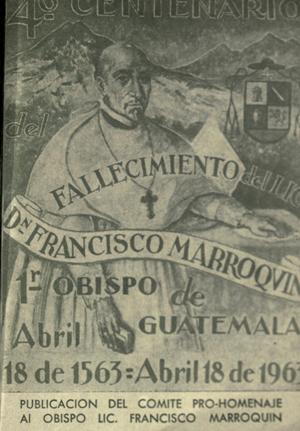
Publication for the "4th centenary of illustrious Don Francisco Marroquín's decease, first bishop of Guatemala
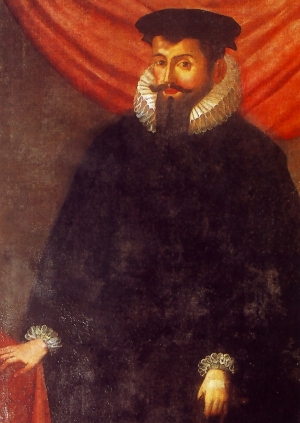
Antonio de Mendoza, Viceroy of Nueva España and afterwards of Peru. XVIIIth century canvas, Museo Nacional de Antropología e Historia, Lima Pueblo Libre.
